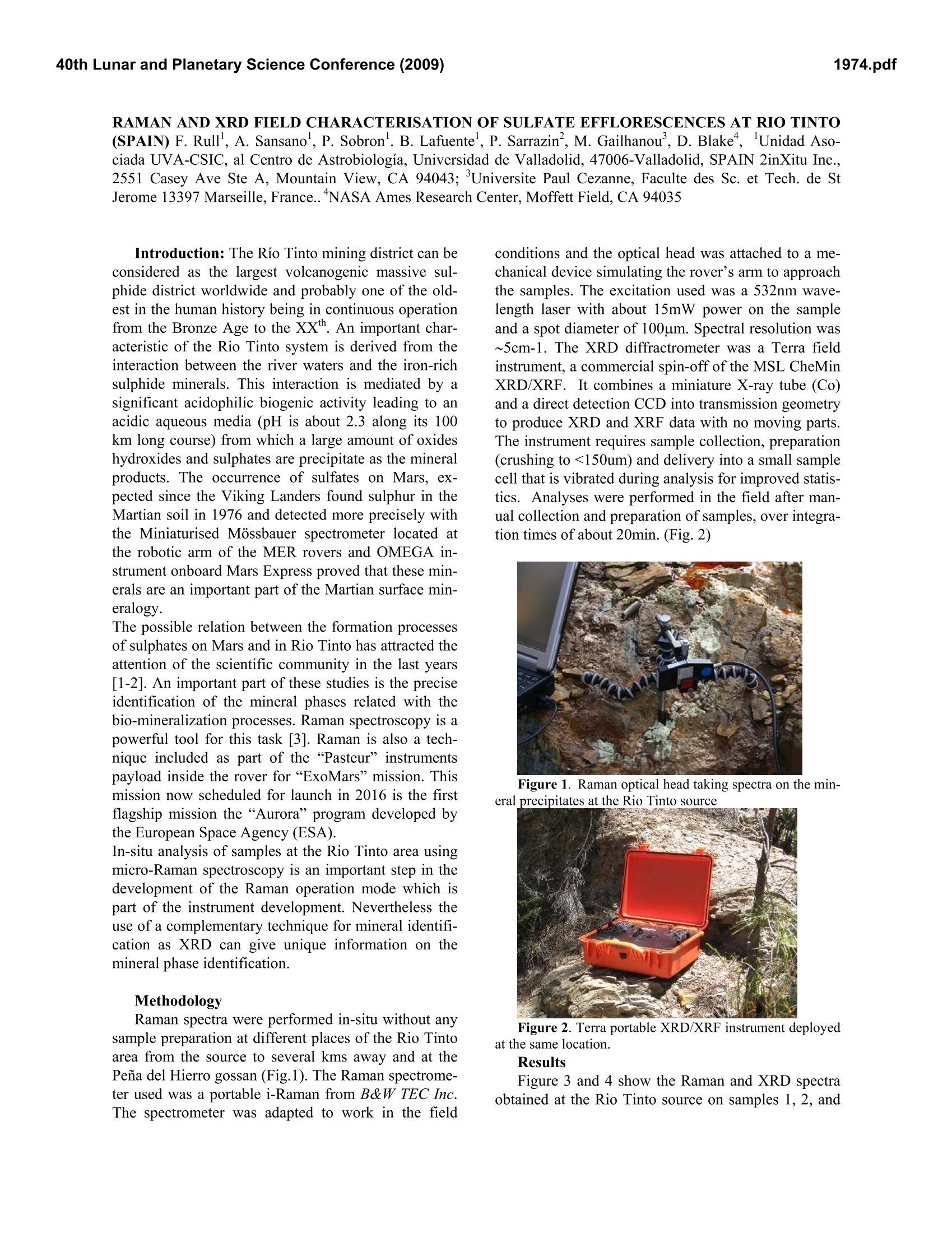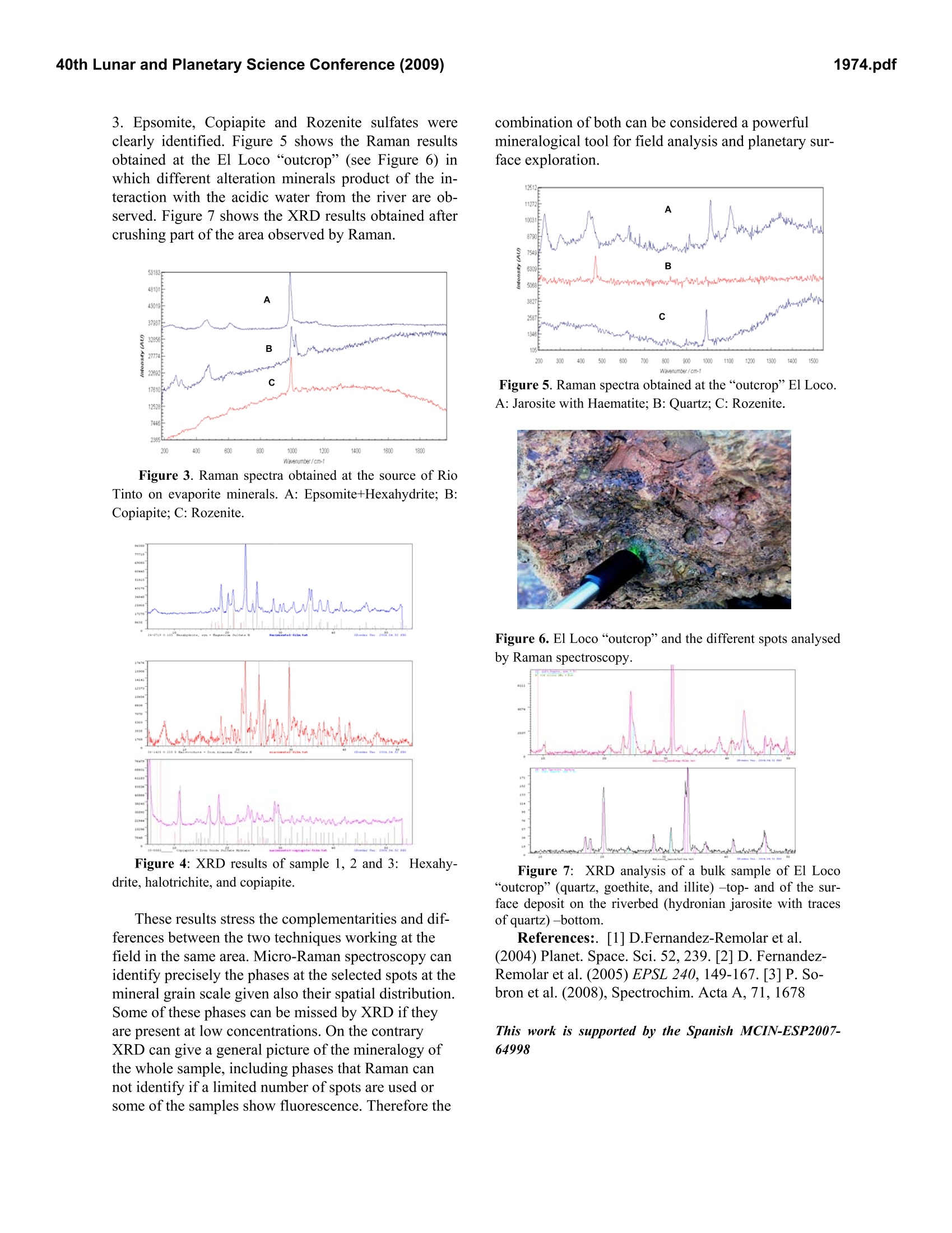
方案详情
文
力拓矿业区被认为是世界上最大的和最古老的源于火山喷发而形成的硫酸盐矿物去。力拓矿业区一个显著地特点是河水和富含硫铁矿的彼此作用,而一种嗜好酸性的微生物的活动则产生了大量的氧化物、氢氧化物、硫化物等从而形成了硫酸盐矿区。在最近几年里,关于火星上硫酸盐矿物的形成过程与力拓矿区可能存在的联系引起了科学界的广泛关注。使用莱曼光谱和XRD能很好的分析硫酸盐矿物的形成过程。
方案详情

40th Lunar and Planetary Science Conference (2009)1974.pdf RAMAN AND XRD FIELD CHARACTERISATION OF SULFATE EFFLORESCENCES AT RIO TINTO(SPAIN) F. Rull, A. Sansano, P. Sobron. B. Lafuente, P. Sarrazin’, M. Gailhanou’, D. Blake, Unidad Aso-ciada UVA-CSIC, al Centro de Astrobiologia, Universidad de Valladolid, 47006-Valladolid, SPAIN 2inXitu Inc.,2551 Casey Ave Ste A, Mountain View, CA 94043; Universite Paul Cezanne, Faculte des Sc. et Tech. de StJerome 13397 Marseille, France..NASA Ames Research Center, Moffett Field, CA 94035 Introduction: The Rio Tinto mining district can beconsidered as the largest volcanogenic massive sul-phide district worldwide and probably one of the old-est in the human history being in continuous operationfrom the Bronze Age to the XX". An important char-acteristic of the Rio Tinto system is derived from theinteraction between the river waters and the iron-richsulphide minerals. This interaction is mediated by asignificant acidophilic biogenic activity leading to anacidic aqueous media (pH is about 2.3 along its 100km long course) from which a large amount of oxideshydroxides and sulphates are precipitate as the mineralproducts. The occurrence of sulfates on Mars, ex-pected since the Viking Landers found sulphur in theMartian soil in 1976 and detected more precisely withthe Miniaturised Mossbauer spectrometer located atthe robotic arm of the MER rovers and OMEGA in-strument onboard Mars Express proved that these min-erals are an important part of the Martian surface min-eralogy. The possible relation between the formation processesof sulphates on Mars and in Rio Tinto has attracted theattention of the scientific community in the last years[1-2]. An important part of these studies is the preciseidentification of the mineral phases related with thebio-mineralization processes. Raman spectroscopy is apowerful tool for this task [3]. Raman is also a tech-nique included as part of the“Pasteur” instrumentspayload inside the rover for“ExoMars”mission. Thismission now scheduled for launch in 2016 is the firstflagship mission the“Aurora”program developed bythe European Space Agency (ESA). In-situ analysis of samples at the Rio Tinto area usingmicro-Raman spectroscopy is an important step in thedevelopment of the Raman operation mode which ispart of the instrument development. Nevertheless theuse of a complementary technique for mineral identifi-cation as XRD can give unique information on themineral phase identification. Methodology Raman spectra were performed in-situ without anysample preparation at different places of the Rio Tintoarea from the source to several kms away and at thePena del Hierro gossan (Fig.1). The Raman spectrome-ter used was a portable i-Raman from B&W TEC Inc.The spectrometer was adapted to work in the field conditions and the optical head was attached to a me-chanical device simulating the rover’s arm to approachthe samples. The excitation used was a 532nm wave-length laser with about 15mW power on the sampleand a spot diameter of 100um. Spectral resolution was~5cm-1. The XRD diffractrometer was a Terra fieldinstrument, a commercial spin-off of the MSL CheMinXRD/XRF. It combines a miniature X-ray tube (Co)and a direct detection CCD into transmission geometryto produce XRD and XRF data with no moving parts.The instrument requires sample collection, preparation(crushing to <150um) and delivery into a small samplecell that is vibrated during analysis for improved statis-tics. Analyses were performed in the field after man-ual collection and preparation of samples, over integra-tion times of about 20min. (Fig.2) Figure 1. Raman optical head taking spectra on the min-eral precipitates at the Rio Tinto source Figure 2. Terra portable XRD/XRF instrument deployedat the same location. Results Figure 3 and 4 show the Raman and XRD spectraobtained at the Rio Tinto source on samples 1, 2, and 3. Epsomite, Copiapite and Rozenite sulfates wereclearly identified. Figure 5 shows the Raman resultsobtained at the El Loco “outcrop” (see Figure 6) inwhich different alteration minerals product of the in-teraction with the acidic water from the river are ob-served. Figure 7 shows the XRD results obtained aftercrushing part of the area observed by Raman. Figure 3. Raman spectra obtained at the source of RioTinto on evaporite minerals. A: Epsomite+Hexahydrite; B:Copiapite; C:Rozenite. These results stress the complementarities and dif-ferences between the two techniques working at thefield in the same area. Micro-Raman spectroscopy canidentify precisely the phases at the selected spots at themineral grain scale given also their spatial distribution.Some of these phases can be missed by XRD if theyare present at low concentrations. On the contraryXRD can give a general picture of the mineralogy ofthe whole sample, including phases that Raman cannot identify if a limited number of spots are used orsome of the samples show fluorescence. Therefore the combination of both can be considered a powerfulmineralogical tool for field analysis and planetary sur-face exploration. Figure 5. Raman spectra obtained at the “outcrop"El Loco.A: Jarosite with Haematite; B: Quartz; C: Rozenite. Figure 6. El Loco“outcrop"and the different spots analysedby Raman spectroscopy. Figure 7:XXRD analysis of a bulk sample of El Loco“outcrop”(quartz, goethite, and illite) -top- and of the sur-face deposit on the riverbed (hydronian jarosite with tracesof quartz)-bottom. References:. [1]D.Fernandez-Remolar et al. (2004) Planet. Space. Sci. 52, 239.[2] D. Fernandez-Remolar et al. (2005) EPSL 240, 149-167.[3] P. So-bron et al. (2008),Spectrochim.Acta A,71,1678 This work is supported by the Spanish MCIN-ESP2007-64998
确定


还剩1页未读,是否继续阅读?
深圳市莱雷科技发展有限公司为您提供《硫酸盐矿物中形成过程检测方案(X射线衍射仪)》,该方案主要用于非金属矿产中形成过程检测,参考标准--,《硫酸盐矿物中形成过程检测方案(X射线衍射仪)》用到的仪器有
相关方案
更多








